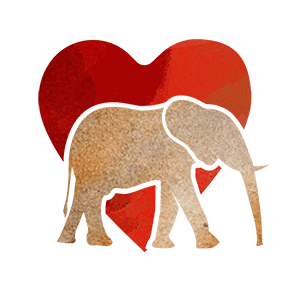The name “Taru” is taken from the Taru Desert, which, in essence, is what is today’s Tsavo National National Park. Being arid semi desert country, the Taru Desert formed an effective barrier between the Coast and inland, simply an unexplored, uninhabited and hostile chunk of wilderness before the Railway opened up what was Colonial British East Africa at the turn of the 20th Century.
Elephant “Taru” was driven to the Nairobi Nursery in the back of a small Renault 4 Van, which was the only transport the Trust had at that point in time.
There, he joined the Trust’s very first Nursery elephant, “Olmeg”, who was older by just 3 months. They became firm friends, of course, and shared the Nursery with two orphaned rhinos named “Sam” and “Amboseli”. Rhino “Sam” was orphaned having been attacked by lions in the Masai Mara, and “Amboseli’s” mother was killed by poachers in Amboseli National Park who removed her horn. Today, her claim to fame is that she is the last living Amboseli rhino, carrying those famous long-horned genes, exceptionally long horns being a feature of the Amboseli rhinos. (She is now free in Tsavo National Park and the mother of several wild born calves). Sadly, “Sam” ended up being tusked by a bull elephant who contested his right to a mudwallow in the Mbololo riverbed in Tsavo East, inflicting an injury that proved fatal, so we lost him).
![]()
During the Nursery period of the Trust’s first two orphaned elephants, and the two rhino orphans, Taru inserted the tip of his trunk into Sam the rhino’s mouth, and got it inadvertently bitten, practically severing one finger of the trunk and leaving the other hanging by a thread! (Rhinos have huge clipping molars that can cut through quite large branches just like a pair of secateurs!)
The Vet was hastily summoned to stich back Taru’s detached “finger” under anaesthesia, an operation that looked successful. However, it proved otherwise, because as soon as the elephant had recovered from the anaesthetic, he systematically worked on the stitches until they trailed behind him like string! Since re-stitching it seemed fruitless, and would simply subject him to the rigours of another anaesthetic, the decision was made to “let Nature take its course” and see what happened, fearing that the blood supply to the remaining “finger” would prove insufficient to save it. In fact, we were proved wrong, and Taru’s one finger remained in situ, giving him at least almost full use of the tip of his trunk.
![]()
![]()
Taru and Olmeg were moved to Tsavo East after both elephants had passed their second birthday, and immediately became part of “Eleanor’s” unit. By now, besides “Eleanor” herself, this comprised another young cow named “Mary”, recently freed from the Mount Kenya Safari Park, “Lissa”, also a poaching orphan from the Mackinnon Road area, and “Chuma” who was another Tsavo orphan, roughly the same age as Olmeg, with whom Olmeg became obsessively competitive. The unit was joined periodically by an outsider given the name “Thomas”, who was also obviously a wild orphan seeking company, and whom Olmeg befriended. With the help of “Thomas”, Olmeg enjoyed a brief superiority over his rival “Chuma”, though not for long, for Thomas opted out to join a wild herd! Being younger, Taru , who had always been an independent character, remained neutral and did not engage in these contests for dominance.
![]()
“Mary” came to us aged 11, and when she was 14, she gave birth to a bull calf we named “Don” in honour of Don Hunt, who granted her freedom. Immediately, Eleanor tried to take possession of the new baby, denying Mary access to her calf, who was desperate for, and needed, milk. This, of course, Eleanor did not have and the situation looked fraught until the young bulls, including Taru, ganged up, and escorted the baby back to its rightful mother. Mary then took possession of her calf and left Eleanor’s unit to join another wild family where she has remained permanently, seeing no reason to renew human contact again. By 2005 Mary would probably have two or three babies of her own, so she has been one of the Trust’s greatest triumphs, truly a “wild” elephant again in every sense of the word.
Taru is another success story. When he was ten, he left the orphan unit, along with the other young orphaned bulls, namely Olmeg, Dika, Ndume and Edo, to seek the company of other young wild bull friends, according to the dictates of bull elephant society. Although he returned to the Stockades on several occasions these visits have become less frequent with the passing of time, and he has now been out of touch for the past 4 years. Today, like Olmeg, he would be a handsome young bull who in August 2005 will have turned 18 years of age.













